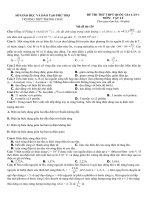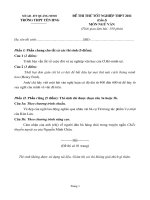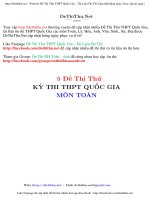Tải Đề thi thử tốt nghiệp THPT lần 1 môn tiếng Anh trường THPT Chuyên Quốc Học Huế - Đề thi tiếng Anh THPT Quốc Gia 2020 có đáp án
Bạn đang xem bản rút gọn của tài liệu. Xem và tải ngay bản đầy đủ của tài liệu tại đây (119.77 KB, 9 trang )
<span class='text_page_counter'>(1)</span><div class='page_container' data-page=1>
<b>ĐỀ THI THỬ THPTQG MÔN TIẾNG ANH</b>
<b>NĂM 2020 CÓ ĐÁP ÁN</b>
<b>Read the following passage and mark the letter A, B,C or D on your answer sheet to</b>
<b>indicate the correct word or phrase that best first each of the numbered blank from 1 to 5</b>
American folk music originated with (1) people at a time when the rural
population was isolated and music was not (2) spread by radio, records, or
music video. It was (3) by oral traditional and is noted for its energy ,humor, and emotional
impact. The major source of aerly American folk songs was music from the Bristish Isles , but
songs from Africa as songs of the American Indians have significant part in its heritage. Later
settler from other countries also contributed songs. In the nineteenth century, composer Steven
Foster wrote some of the most enduringly popular of all American songs ,(4) soon became
part of the folk tradition. Beginning in the 1930s , Woody Guthrie gained great popularity by
adapting melodies and lyrics and supplying new ones as well. In the 1950s and 1960s , singer –
composers such as Peter Seeger , Bob Dylan , Joan Baez continued this tradition by „urban’ folk music.
Many of these songs deal (5) important social issue, such as racial intergration and the war
in Vietnam.
<b>Question 1:</b> <b>A. typical</b> <b>B. ordinary</b> <b>C. common</b> <b>D. popular</b>
<b>Question 2:</b> <b>A. yet</b> <b>B. still</b> <b>C. until</b> <b>D. even</b>
<b>Question 3:</b> <b>A. transferred</b> <b>B. transited</b> <b>C. transmitted</b> <b>D. transformed</b>
<b>Question 4:</b> <b>A. who</b> <b>B. which</b> <b>C. that</b> <b>D. this</b>
<b>Question 5:</b> <b>A. with</b> <b>B. in</b> <b>C. by</b> <b>D. at</b>
<b>Mark the letter A, B, C, or D on your answer sheet to indicate the word(s)</b>
<b>CLOSET in meaning to the underlined word(s) in each of the following question.</b>
<b>Question 6: In order to better understand English, the students incorporated gramar,</b>
vocabulary, and speaking in their stidies.
<b>A.</b>Combined <b>B. granted</b> <b>C. scrutinized</b> <b>D.</b>
skipped
</div>
<span class='text_page_counter'>(2)</span><div class='page_container' data-page=2>
<b>A. blend</b> <b>B. concentrate</b> <b>C. secede</b> <b>D. desensitize</b>
<b>Mark the letter A, B, C, or D on your answer sheet to indicate the word(s) OPPOSITE in</b>
<b>meaning to the underlined word(s) in each of the following question.</b>
<b>Question 8: Slavery was abolished in the US in the 19</b>th<sub> century.</sub>
A. eradicated <b>B. instituded</b> <b>C. eliminate</b> <b>D. required </b>
<b>Question 9: The distinction between schooling and education implied by this remark</b>
is important.
<b>A. odd</b> <b>B. implicit</b> <b>C. obscure</b> <b>D. explicit</b>
<b>Mark the letter A, B, C, or D on your answer sheet to indicate the sentence that is closet in</b>
<b>meaning to each of the following question.</b>
<i><b>Question 10: “I would like you not to play computer games any more, Amber” said her mother.</b></i>
<b>A.</b>Amber’s mother would rather she doesn’t play computer games any more.
<b>B.</b>Amber’s mother would rather her not to play computer games any more
<b>C.</b>Amber’s mother would rather she didn’t play computer games any more.
<b>D.</b>Amber’s mother would rather she wouldn’t play computer games any more.
<b>Question 11: It is a pity that I can’t speak English as native speaker.</b>
<b>A.</b>I wish I could speak English as a native speaker
<b>B.</b>I wish I couldn’t speak English as a native speaker
<b>C.</b>I wish I can speak English as a native speaker
<b>D.</b>I wish I have spoken English as a native speaker
<b>Question 12: The music was so loud that we had to shout to each other.</b>
<b>A.</b>We didn’t say loud enough for us to hear each other
<b>B.</b>The music was too loud that we had to shout to each other.
<b>C.</b>We didn’t say loud enough to hear each other
<b>D.</b>Because of loud music,we had to shout to each other.
</div>
<span class='text_page_counter'>(3)</span><div class='page_container' data-page=3>
<b>part differs from the other three in the pronunciation in each of the following questions.</b>
<b>Question 13:</b> <b>A. appreciate</b> <b>B. efficient</b> <b>C. suspicious</b> <b>D. apprentice</b>
<b>Question 14:</b> <b>A. assure</b> <b>B. press</b> <b>C. blessing</b> <b>D. classic</b>
<i><b>Mark the letter A,B,C or D on your answer sheet to indicate the word that differs</b></i>
<i><b>from the other three in the position of primary stress in each of the following</b></i>
<i><b>questions.</b></i>
<b>Question 15:</b> <b>A. punishment</b> <b>B. behavior</b> <b>C. influence</b> <b>D. regional</b>
<b>Question 16:</b> <b>A. acquaintance</b> <b>B. symbolize</b> <b>C. etiquette</b> <b>D. socialize</b>
<i><b>Mark the letter A,B,C or D on your answer sheet to indicate the underlined part needs</b></i>
<i><b>correction in each of the following questions.</b></i>
<b>Question 17: Ceramic can be harder, light, and more resistant to heat than metals.</b>
<b>A</b> <b>B</b> <b>C</b> <b>D</b>
<b>Question 18: It is now believed that some damage to tissues may result from exposing</b>
it to frequent X-ray <b>A</b> <b>B</b> <b>C</b>
<b>D </b>
<b>Question 19: The museum contains sixth century sculptures, eighteenth century</b>
swords and
<b>A</b> <b>B</b>
the dress won by nineteenthcenturyroyal family.
<b>C</b> <b>D</b>
<b>Mark the letter A,B,C or D on your answer sheet to indicate the correct answer to each of</b>
<b>ther following questinons.</b>
<b>Question 20: The rhinoceros, whose numbers have dropped alarmingly recently, has</b>
been declared a/an species.
A. danger <b>B. endanger</b> <b>C. endangered</b> <b>D. dangerous</b>
<b>Question 21: A curriculum that ignores ethnic tensions, racial anlagonisms, cultural</b>
______and religiousdifferences is not relevant.
<b>A. conlacts</b> <b>B. barriers</b> <b>C. diversity</b> <b>D. levels</b>
</div>
<span class='text_page_counter'>(4)</span><div class='page_container' data-page=4>
priority.
A. belief <b>B. fact</b> <b>C. possibility</b> <b>D. question </b>
<b>Question 23: A recent survey has shown that supporters of equal partnership in marriage are</b>
in the _______
<b>A. crowd</b> <b>B. particular</b> <b>C. obligation</b> <b>D. majority</b>
<b>Question 24: The effects of literacy often extend </b> personal benefits.
<b>A. after</b> <b>B. beneath</b> <b>C. over</b> <b>D. beyond</b>
<b>Question 25: Instructors from the same ecological and vocational background as</b>
illiterates are more successful in literacy classes than school-teachers.
A. carrying out <b>B. pulling out</b> <b>C. acting out</b> <b>D. calling</b>
out
<b>Question 26: For a public campaing to succeed, it is important to make ______</b> of
existing social organizations as well as other relations.
<b>A. fun</b> <b>B. advantage</b> <b>C. benefit</b> <b>D. use</b>
<b>Question 27: The British and the American share the same language, but in other</b>
aspects they are as different as _
<b>A. cats and dogs</b> <b>B. chalk and cheese C. salt and pepper</b> <b>D. here and there</b>
<b>Question 28: Had it not been for your support, we couldn’this plan.</b>
A. have completed <b>B. complete</b>
<b>C. be completed</b> <b>D. have been completed</b>
<b>Question 29: - I have gone to the doctor's to have a check up.</b>
- You .You just had your check-up last week!
A. didn't need to go <b>B. needn’t have gone</b>
<b>C. needn’t go</b> <b>D. don’t need to go</b>
<b>Question 30: In the kitchen there is a table .</b>
<b>A. beautiful large round wooden</b> <b>B. large beautiful wooden round</b>
</div>
<span class='text_page_counter'>(5)</span><div class='page_container' data-page=5>
<b>Question 31: Everyone knows about pollution problems, but not many people have any</b>
solution.
<b>A. come up with</b> <b>B. looked into</b> <b>C. thought over</b> <b>D. got round to</b>
<b>Mark the letter A,B,C or D on your answer sheet to indicate the most suitable response to</b>
<b>complete each of the following exchanges.</b>
<b>Question 32: Two friends Diana and Anne are talking about Anne’s new hairstyle.</b>
- Diana: “ That new hairstyle suits you perfectly, Anne.”
- Anne “ …………..”
<b>A. Never mind</b> <b>B. Don't mention it</b>
<b>C. Thank you</b> <b>D. You re welcome.</b>
<b>Question 33: Mary is talking to a porter in the hotel</b>
lobby Porter: “Shall I help you with your suitcase?” Mary: “
.”
<b>A. Not a chance.</b> <b>B. That's very kind of you.</b>
<b>C. I can’t agree more.</b> <b>D. What a pity!</b>
<b>Read the following pasage and mark the letter A. B, C or D on your answer sheet to</b>
<b>indicate the correct answer to each of the questions from 34 to 40.</b>
As computers have become powerful tools for rapid and economic of production of
picture, computer graphics has emerged as one of the most rapidly growing fields in
<b>computers scienee. It such used routinely in such diverse areas as business, industry,</b>
government, research, training, and madiecine.
</div>
<span class='text_page_counter'>(6)</span><div class='page_container' data-page=6>
for simulated “walk” through the rooms or around the outside of the building.
Business graphics is another rapidly growing are of computer graphics, where it is to
create graphs, charts, and cost models summarize financial, statistical, msthematieal,
scientific, and economic data. As an education aid, computer also has creative and
<b>commencial art applications, where it is used in advertissing, publishing and film</b>
productions, particulurly for computer animation, which is achieved by a sequential
process.
<b>Question 34: What does the passage mainly discuss?</b>
<b>A.</b>Routine uses of computers
<b>B.</b>Computer graphic applications
<b>C.</b>The rapidly grown ag field of camrater science
<b>D.</b>Computers as the architects af the future
<b>Question 35: The word “it” in line 2 refers to...</b>
<b>A. computer graphics B. computer science C. field</b> <b>D. computer</b>
<b>Question 36: According to the passage, engineers use CAD for ...</b>
<b>A. A simulated “walk” through modal rooms</b> <b>B. Rendering machine parts</b>
<b>C. Making cost models</b> <b>D. Advertising products</b>
<b>Question 37: Which of the following is NOT mentioned as a use of computer graphic</b>
in business?
<b>A. charts</b> <b>B. cost models</b> <b>C. graphs</b> <b>D. hiring</b>
<b>Question 38: The word"applications" in the third paragraph means ...</b>
<b>A. jobs</b> <b>B. uses</b> <b>C. creators</b> <b>D. layers</b>
<b>Question 39: It can be inferred from the last paragraph that………. relies heavily on</b>
computer graphics
<b>A. making cartoons</b> <b>B. growing crops</b>
<b>C. producing drugs</b> <b>D. Playing sports</b>
</div>
<span class='text_page_counter'>(7)</span><div class='page_container' data-page=7>
<b>A. sarcastic</b> <b>B. neutral</b> <b>C. pessimistic</b> <b>D. doubtful</b>
<b>Read the following pasage and mark the letter A. B, C or D on your answer sheet</b>
<b>to indicate the correct answer to each of the questions from 41 to 48.</b>
Another critical factor that plays a part in susceptibility to colds is age. A study done
<b>by the University of Michigan School of Public Health revealed particulars that seem</b>
to hold true for the general population. Infants are the most cold-ridden group,
averaging more than six colds in their first year. Boys have more colds than girls up to
age three. After the age of three, girls are more susceptible than boy's , and teenege
girls average three colds a year to boy’s two.
The general incidence of continues to decline into maturity. Elderly people who are in
good health have as few as one or two colds annually. One exception is founds among
people in the twentics, especially women, who show a rise in cold infections, because
people in this age group are most likely to have young children. Adults who delay
having children until thirties forties experience the same sudden increase in cold
infections.
The study also found that economics play an important role. As income increases, the
frequency at which are reported in the family decreases. Families with the lowest
income suffer about a third more colds than families at the lower end. Lower income
generally forces people to live in more cramped quarters than those typically occupied
by wealthier by wealthier people, and crowding increses the opportunities for the cold
virus totravel from person to person. Low income may also adversely influence diet.
The degree to which poor nutrition affects susceptibility to colds is not yet clearly
established, but an inadequate diet is suspected of lowering resistance generally.
(source: TOEFL reading)
<b>Question 41: Which of the following is closet in meaning to the word “particulars” in line 22?</b>
A. Minor errors <b>B. specific facts</b> <b>C. small distinctions D. individual people</b>
<b>Question 42: What does the author claim about the study discussed in the passage?</b>
<b>A.</b>It contains many inconsistencies
</div>
<span class='text_page_counter'>(8)</span><div class='page_container' data-page=8>
<b>C.</b>It contradicts the results of earlier studies in the field
<b>D.</b>Its results apparently are relevant for the population as a whole
<b>Question 43: It maybe inferred from the passage that which of the following groups of</b>
people is most likely to catch colds?
A. infant boys <b>B. oung girls</b> <b>C. teenage boys</b> <b>D. elderly women </b>
<b>Question 44: There is information in the second paragraph of the passage to support</b>
which of the following conclusions?
<b>A.</b>Men are more susceptible to cold than women
<b>B.</b>Children infect their parents with colds.
<b>C.</b>People who live in a cold climate have more colds than those who live in a warm
one.
<b>D.</b>People who don’t have children are more susceptible to colds than those who do.
<b>Question 45: The phrase “in this age group” refers to</b>
<b>A. Infants</b> <b>B. People in their twenties</b>
<b>C. People in their thirties and forties</b> <b>D. Elderly people</b>
<b>Question 46: The author’s main purpose in writing the last paragraph of the passage is to</b>
<b>A.</b>Explain how cold viruses are transmitted
<b>B.</b>Prove that a poor diet cause colds
<b>C.</b>Discuss the relationship between income and frequency of colds
<b>D.</b>Discuss the distribution of income among the people in the study
<b>Question 47: The word “cramped” is closest in meaning to</b>
<b>A. Cheap</b> <b>B. Crowded</b> <b>C. depressing</b> <b>D. simple</b>
<b>Question 48: The author’s tone in this passage could best be described as</b>
<b>A. Neutral and objective</b> <b>B. Humorous</b>
<b>C. Tentative but interested</b> <b>D. Highly critical</b>
</div>
<span class='text_page_counter'>(9)</span><div class='page_container' data-page=9>
<b>combines each pair of sentences in the following questions.</b>
<b>Question 49: She tried very hard to pass the driving test. She could hardly pass it.</b>
<b>A.</b>Although she didn’t try hard to pass pass the driving test, she could pass it.
<b>B.</b>Despite being able to pass the driving test, she didn’t pass it.
<b>C.</b>Hard as she tried, she could hardly hard pass the driving test
<b>D.</b>She tried very hard, so she passed the driving test satisfactorily
<b>Question 50: We didn’t want to spend a lot of money. We stayed in a cheap hotel</b>
<b>A.</b>In stead of spending a lot of money, we stayed in a cheap hotel.
<b>B.</b>In spite of spending a lot of money, we stayed in a cheap hotel
<b>C.</b>We stayed in a cheap hotel, but we had to spend a lot of money.
<b>D.</b>We didn’t want to spend a lot of money. We stayed in the cheap hotel
<b>Đáp án</b>
1-B 2-A 3-C 4-B 5-A 6-A 7-A 8-B 9-D 10-C
11-A 12-D 13-D 14-A 15-B 16-A 17-A 18-D 19-C 20-C
21-C 22-D 23-D 24-D 25-A 26-D 27-B 28-A 29-B 30-A
31-A 32-C 33-B 34-B 35-A 36-B 37-D 38-B 39-A 40-B
41-B 42-D 43-A 44-B 45-C 46-C 47-B 48A- 49-C 50-A
</div>
<!--links-->









